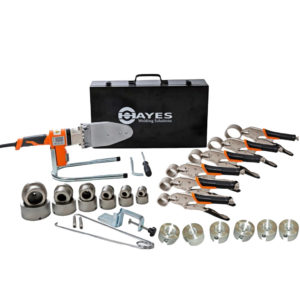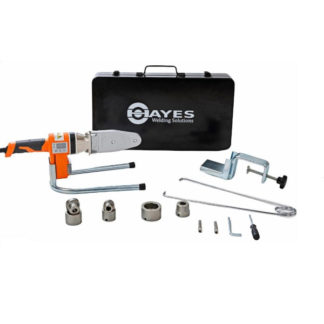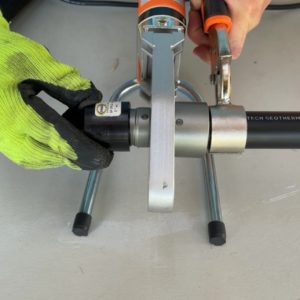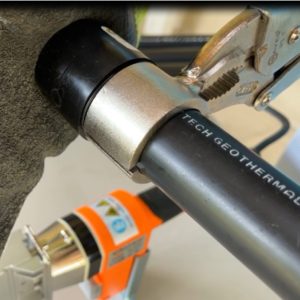HAYES Socket Fusion Pipe Welder
HY PRO Series
USER’S MANUAL
A manual is only a manufacturer´s guide. It does not take the place of proper training by qualified instructors and does not exceed the experience of a professional. The information in this manual is operational and cannot cover all the situations that may occur in the field such as environmental temperature, pipe material, thickness, selected welding standard, etc.
BEFORE THE WELDING PROCESS
A. Cut and chamfer the pipe.
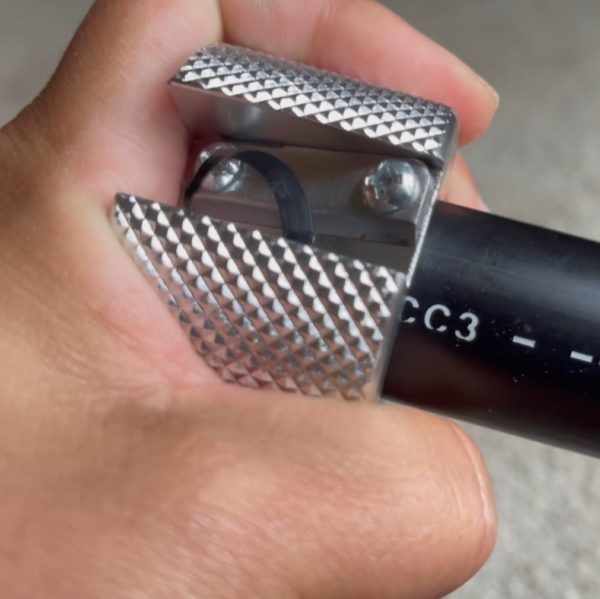
B. Place the cold ring at the proper depth on the pipe as determined by the depth gauge.

C. Attach the coated heating adapters to the heating tool when the tool is cold.
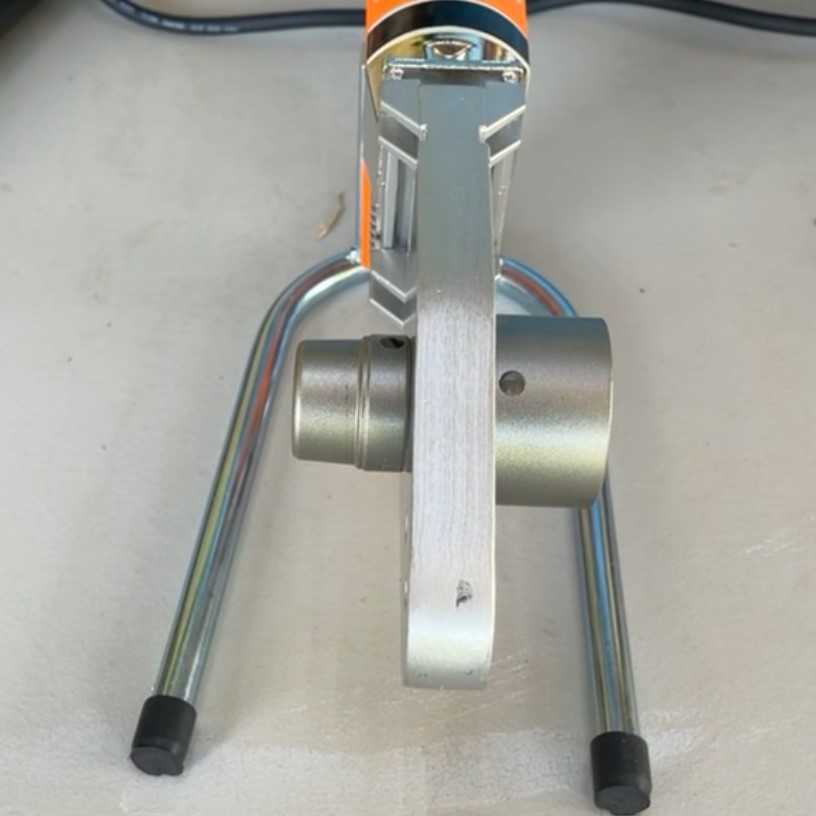
D. Connect to a 110V grounded power source only and begin operating the welding machine. Permit enough preheating to stabilize the temperature.
MACHINE SET UP
- Once the unit is connected to proper power source it will automatically turn on and begin to heat to the temperature that is set.
- Set the desired temperature by pressing the button and then using the “up/down” buttons to choose the proper temperature and then press SET button again to start the heating process.
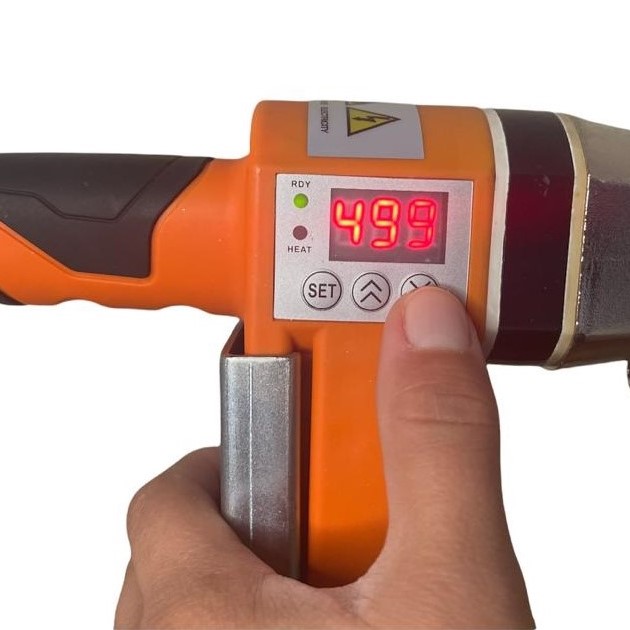
- Red light displays when the unit is in process of heating up.
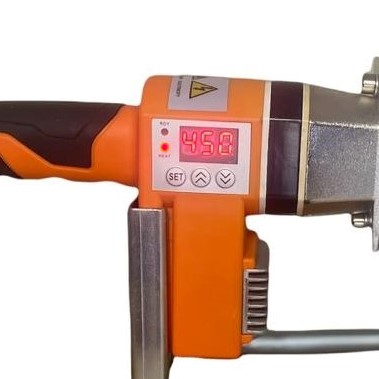
- Green light displays when the unit has reached the desired temperature.
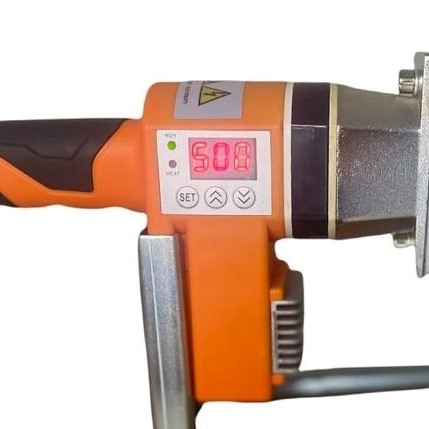
WELDING PROCESS
Put the pipes and fittings into the heating adapters, remove pipes and the fittings from the heating adapters when they reach the proper heating time cycle. Connect the pipes and fittings together until the bead is formed.
IMPORTANT NOTES
Welding procedure
- Skill and knowledge are required to obtain a good quality joint.
- Ensure you select the proper temperature according to the pipe manufacturer’s recommendation.
- It is important to know the technical information before you use your heating tool.
Non-stick coating
The heating adapters have a coated surface that has been treated to reduce polymer adhesion. If the polymer adheres to the heating plate, lightly wipe with a clean cotton cloth to remove. Do not use a wire brush or an abrasive.
Welding parameters
Pipe and fitting manufacturers have established qualified fusion procedures which should be followed precisely. You should obtain a copy of the pipe manufacturer’s procedures or appropriate joining standard for the pipe being fused.
Heating iron temperature
To meet pipe manufacture’s temperature specifications, the surface temperature of the heating adapters should be measured with a surface pyrometer prior to initial use and at reasonable time intervals thereafter.
Ensure you test the temperature on the surface of the heating adapters and not on the heating plate itself. The heater’s built-in thermometer indicates internal temperature and should only be used for reference.
CAUTION
Heating iron
- The heater is to be used with AC power only. Check heater to confirm correct power requirements and only use a power source with the correct voltage and current capacity.
- Connect heating tool to power and permit sufficient preheating to stabilize the temperature before the welding process.
- When welding, if temperature adjustment is needed, please turn off the heating tool first and turn it on again to adjust the new temperature. Adjustment of the temperature when it is already set will damage the temperature control components.
It is recommended to use an insulated heater bag to store the heating tool when it is hot.
¡WARNING!
Avoid Injury
This unit must be operated by trained personnel only.
Industrial Safety
RISK MATRIX
Be alert and report anything that you see, feel, smell or hear differently than expected, or that you think is unsafe.
SOURCE: Heating tool and heating adapters
Do not adjust temperature above 575 °F. This can result in damage to the heater components and the non-stick surfaces.
| HAZARD | RISK | RISK CONTROL |
| ELECTRICAL | Electrocution | Make sure to use a power source with the correct voltage and current capacity. Connect to a 110V grounded power source only. Keep the cables away from chemical agents or water. |
| THERMAL | Risk of fire | Do not use the machine in atmospheres with explosion risk, due to the presence of gases, flammable vapors, etc Wear protective gloves. Never touch the surface of the heating tool or heating adapters when they are hot. Move the heating plate cautiously when it is hot and carefully remove the heating adapters. |
SOCKET FUSION TIME CYCLES
Click here to see the socket fusion time cycles
Pipe chamfer(c) and Insert depth (d)
NOTE: Some recommend using a 50-60 grit emery or garnet cloth to roughen the outside of the pipe and inside of the fitting as a means of minimizing any possible skin interface when making the fusion. Sandpaper is not recommended for this purpose, as it might disintegrate and contaminate the joint interface.
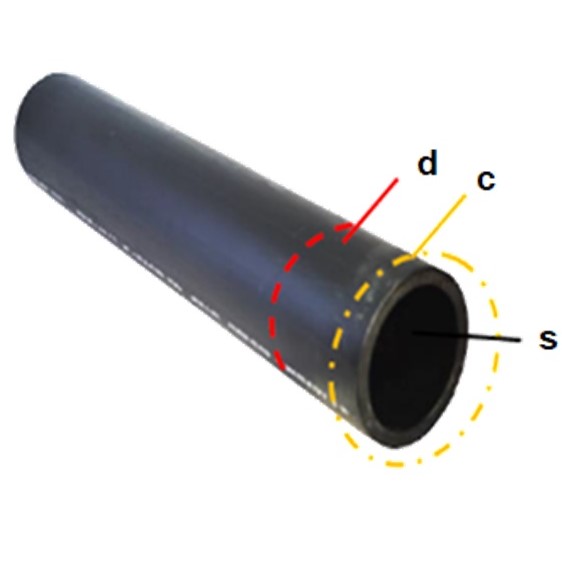
| Pipe Size (s) | Pipe Size (s) | Pipe Chamfer | Insert depth |
| Inches | mm | (c) | (d) |
| 1/2″CTS | 16 | 2 mm | 13 mm |
| 1/2″IPS | 20 | 2 mm | 14 mm |
| 3/4″ | 25 | 2 mm | 15 mm |
| 1″ | 32 | 2 mm | 17 mm |
| 1 1/4″ | 40 | 2 mm | 18 mm |
| 1 1/2″ | 50 | 2 mm | 20 mm |
| 2″ | 63 | 3 mm | 26 mm |
| 2 1/2″ | 75 | 3 mm | 29 mm |
| 3″ | 90 | 3 mm | 32 mm |
| 4″ | 110 | 3 mm | 35 mm |
